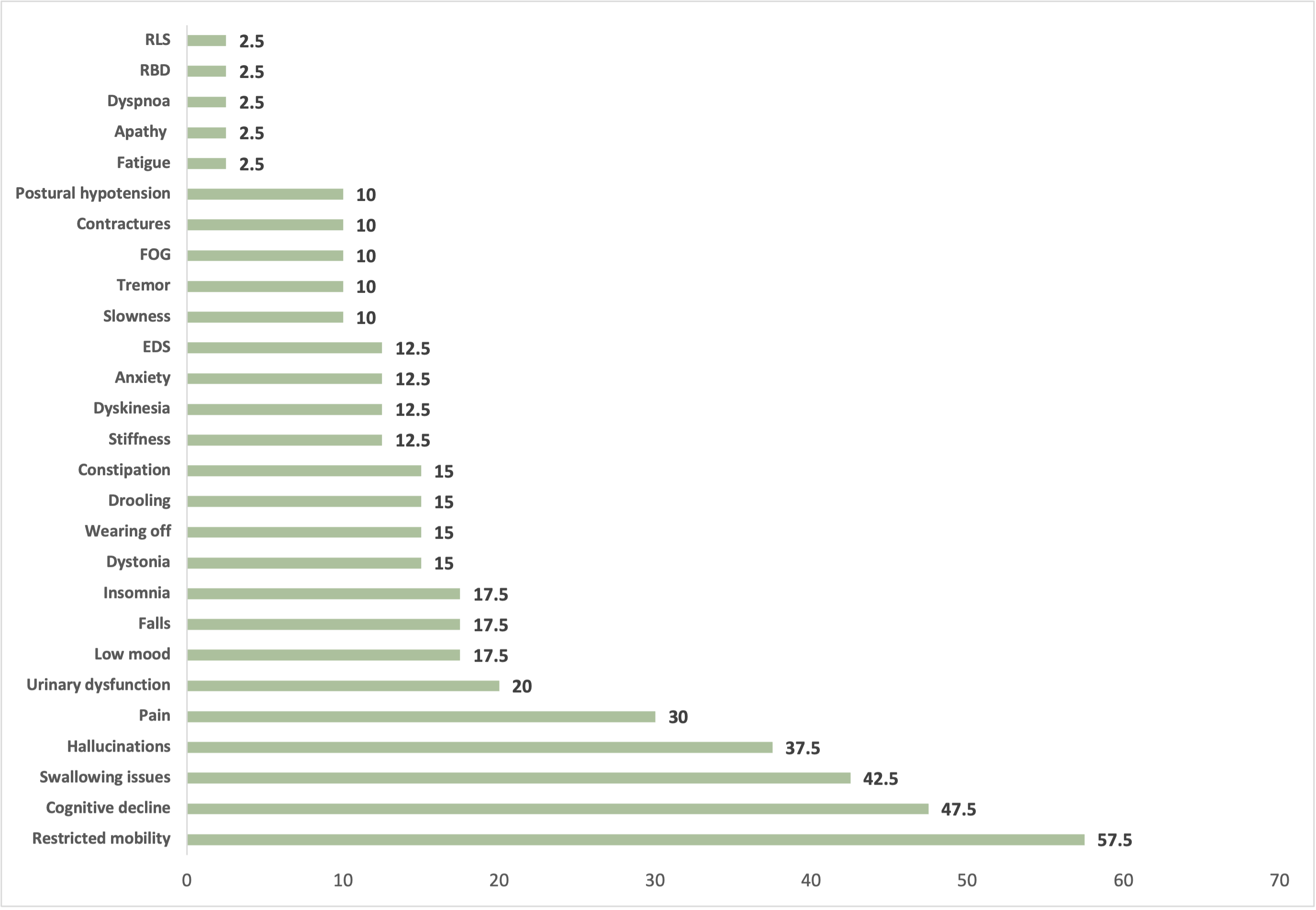Category: Palliative Care
Objective: To assess main issues People with Parkinson’s (PD, PwP) wished to discuss at clinical consultations with movement disorders specialists during the final year of life.
Background: As the end of life approaches, the needs of PwP are increasingly complex, but remain largely unmet, as the traditional palliative care (PC) lacks specific movement disorders expertise and only 1/3 of PwP accesses the outpatient neurology care during the final year of life. [1, 2, 3]
Method: Data from patients who attended Parkinson’s and Movement Disorders Clinics at King’s Parkinson’s Centre, King’s College Hospital, London, UK were captured through routine care in a single electronic health record instance (Sunrise Clinical Manager, Allscripts) and analysed using the CogStack system, with an approval from the King’s Electronic Records Research Interface Committee (KERRI; reference 20230613C) and Community for Research Involvement and Support for People with Parkinson’s (CRISP). [4] Descriptive statistics is provided using IBM SPSS 29.0.2.0. for Mac.
Results: 2572 patients attended Movement Disorders Clinics between July 1 2013 – July 1 2023. There were 275 (10.69%) deaths, with 33.08±25.88 months between the final clinical consultation and death. In the final year of life, 25.82% of individuals (n=71) had ≥1 visit; 56.34% of those (n=40; 37.5% female, age at death 72.66±10.15yrs) had clinical diagnosis of PD (disease duration 11.19±7.20yrs, median H&Y 5(3-5)). As their main concerns, PwP most frequently mentioned restricted mobility, cognitive decline, swallowing issues, hallucinations, and pain. Figure 1.
Conclusion: Distinctive needs of PwP towards the end of life call for individualised care plans targeting specific motor and nonmotor symptoms and necessitate culturally bespoke, multi-professional, interdisciplinary PC approach.
Figure 1.
References: [1] Chaudhuri KR, Rukavina K, McConvey V, Antonini A, Lorenzl S, Bhidayasiri R, et al. The impact of COVID-19 on palliative care for people with Parkinson’s and response to future pandemics. Expert Rev Neurother. 2021;21(6):615-23.
[2] Garon M, Weck C, Rosqvist K, Odin P, Schrag A, Krikmann U, et al. A systematic practice review: Providing palliative care for people with Parkinson’s disease and their caregivers. Palliat Med. 2024;38(1):57-68.
[3] McKenzie ED, Bruno VA, Fong A, Cai P, Earp M, Camicioli RM, et al. Health Care Utilization in the Last Year of Life in Parkinson Disease and Other Neurodegenerative Movement Disorders. Neurol Clin Pract. 2022;12(6):388-96.
[4] Jackson R, Kartoglu I, Stringer C, Gorrell G, Roberts A, Song X, et al. CogStack – experiences of deploying integrated information retrieval and extraction services in a large National Health Service Foundation Trust hospital. BMC Med Inform Decis Mak. 2018;18(1):47.
To cite this abstract in AMA style:
K. Rukavina, M. Al-Agil, K. Poplawska-Domaszewicz, S. Veronese, D. Oliver, K. Ray Chaudhuri. Unmet Motor and Nonmotor Needs of People with Parkinson’s in the Final Year of Life [abstract]. Mov Disord. 2024; 39 (suppl 1). https://www.mdsabstracts.org/abstract/unmet-motor-and-nonmotor-needs-of-people-with-parkinsons-in-the-final-year-of-life/. Accessed April 2, 2025.« Back to 2024 International Congress
MDS Abstracts - https://www.mdsabstracts.org/abstract/unmet-motor-and-nonmotor-needs-of-people-with-parkinsons-in-the-final-year-of-life/

